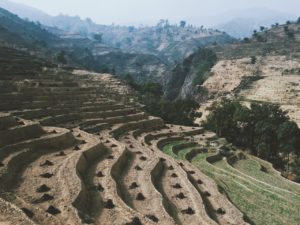Water is an essential aspect of human life. But such philosophical contentions hold little value in the court of law. Judges, while deciding on a case, may interpret the law literally (which is called a positivist approach) or through interpretative derivations. This possibility is always but inconsistently maintained. So tomorrow if a case comes up where a party files a case stating that its right to water has been violated, the court may simply reject (or be led to rejection by a lawyer) in taking up the case saying no laws exist in law that guarantees right to water.
Today, no international legal documents expressly provision the existence of right to water. So does this mean human beings all around the world don’t have right to water?
This paper was written by Nepali Advocate, Harvard alumni and currently Assistant Professor in Kathmandu School of Law Swechhya Sangroula and was published in the Kathmandu School of Law Review in November 2017. The paper explores the presence of right to water in international human rights law texts, arguing that it currently exists in implicit(derived from interpretation) form, and that it should now exist in explicit(expressed) form.
In this paper, the author argues that although right to water doesn’t exist in words today, it implicitly exists in international legal documents. She bases her contention on following arguments:
i) The Committee on Economic, Social and Cultural Rights which is a monitoring mechanism of International Covenant on Economic, Social and Cultural Rights (ICESCR) and a subsidiary organ of Economic and Social Council of the United Nations, noted in its General Comment No.15 in 2002 that ‘the human right to water is indispensable for leading a life in human dignity.’ Such interpretation by a relevant body holds much importance in the understanding of legal contents when presented before a court, therefore suggesting the implicit presence of right to water in ICESCR.
ii) Scholarly writings, i.e opinions and findings of distinguished scholars in the concerned field support the contention that the right to water can be implicitly found in international legal documents. The author draws references from prominent human rights scholars such as Ben Saul, Malcolm Langford and James Nickel, to name a few.
iii) Subsequent state practices should also be observed while deciding on the implicit and explicit contents of a treaty. This is said by the Vienna Convention on the Law of Treaties in Article 31(3) which states that “subsequent agreements and subsequent practice shall be taken into account when a treaty is to be interpreted in light of its object and purpose”. So the author brings examples of South Africa, Bolivia, Kenya, Uruguay as being some of the States which have included the right to water as a fundamental right in respective Articles of their Constitutions.
iv) The position of international organizations on this debate should also be observed and while doing this, the author finds the subsequent practice of the United Nations and its bodies largely favoring the interpretation of the CESCR. She brings forth two examples: first, in 2010, the OHCHR noted in its Fact Sheet No.35 that although water has not been explicitly recognized as a self-standing human right in international treaties, international human rights law entails specific obligations related to access to safe drinking water. Second, in 2010 itself, UN made its position clear by adopting Resolution 64/292 which recognized that the right to safe and clean drinking water is a human right essential for the full enjoyment of life and all human beings.
v) While exploring whether international and domestic jurisdictions have, in past, endorsed the implicit location of right to water in international instruments, the author cites examples of Moselthanyane case (overseen by Botswana Court of Appeal), Angela Poma Poma v. Peru case (verseen by Peruvian court), Attakoya Thangal v. Union of India case (overseen by Indian Court), SERAC v. Nigeria (overseen by Nigerian court), wherein the courts or human rights commissions involved in these cases derived human rights from a number of other explicit rights such as right to life, right to health and even a right against inhuman and degrading treatment. For example, in Atttakoya Thangal v. Union of India, the Indian court stated that right to water exists as a result of the existence of right to life.
In this way, the author establishes right to water as being implicitly located in international legal documents.
Why are we having this debate at all?
Why is right to water not mentioned in international legal documents? And even if it happened to be left out during preparation, why would anyone reject its hidden presence in current texts? To answer this, the author presents two dominating critiques of the right to water:
i) A critique had been put by United States of America which noted: “the fact that the provision of a particular good or service(water) may be essential to the realization of a Covenant right (ICESCR) does not make that good or service itself the subject of a distinct international human rights.”
ii) Another critique is that put up by Stephen Tully who argues that the interpretation of the word ‘including’ could mean that the list of rights to be added would be endless, such as ‘postal delivery’ and ‘access to the internet’, so an amendment to the ICESCR under Article 29 is legally required in order to incorporate the right to water in the treaty.
Since Right to water ‘s implicit position has been located, isn’t the debate over then?
So a hidden right to water exists. Isn’t this vivid enough for courts to consider? Not quite, as the author furthermore argues that an explicit mentioning of right to water is imperative. Her basis are as follows:
i) Even when a right has been understood as an implicit right, as a right deriving from or inseparably attached to other human rights (as a subordinate right), the violation of such right can only be complained of when the parent right-for instance, the right to food, health or life- is violated.
ii) In the absence of an explicit right to water, or at least, the reference to water as a right, and not merely a goal, states are able to get away from their obligations, citing the non-binding authority of the normative content of right to water, as interpreted by the CESCR. So mentioning of water explicitly as a right would safeguard against threats such as the use of water as a tool of discrimination, exclusion and sanctions.
Conclusion:
In this way the author first establishes how a human right to water exists under international human rights law, although implicitly. She further goes on to argue that this right should be explicitly provisioned, as then it becomes a directly claimable right, because of which states will be under a binding legal obligation to refrain from carrying out violations through acts of omission or commission and in case of any violation, the right holders will be in a position to directly claim remedy.
Was this summary helpful?
Mention in the comments section below.
Do not forget to check our other research paper summaries, and general blog posts.











